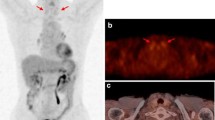Abstract
Positron emission tomography (PET) positive lesions are common in the thyroid. The uptake can be focal or diffuse. Diffuse thyroid uptake is thought to be indicative of autoimmune thyroiditis and not for lesions of malignant potential. Hashimoto’s thyroiditis as a cause for diffusely positive thyroid glands has been demonstrated. We determine the incidence of diffuse thyroid PET positivity in hypothyroid patients, presumed to have Hashimoto’s thyroiditis. The study design was retrospective database and electronic medical record review. The study setting includes tertiary care and academic health sciences center. The subjects were patients at our medical center who underwent positron emission tomography. Hypothyroid patients were identified who had total body PET imaging performed for any reason. Patients were excluded if they were not taking levothyroxine, had a history of neck surgery, neck irradiation, Graves’ disease, taking lithium, thalidomide, amiodarone or interleukin. Patients remaining after the application of these exclusion criteria were presumed to be hypothyroid from Hashimoto’s thyroiditis. Only 9.5% of PET scans of hypothyroid patients display diffuse thyroid activity. Only a small minority of presumed Hashimoto’s thyroiditis patients will display diffuse thyroid activity after PET imaging. The etiology of this effect is unknown. Diffuse thyroid activity rarely requires surgical intervention. Level of evidence: IV.



Similar content being viewed by others
References
Low SC, Sinha AK, Sundram FX (2005) Detection of thyroid malignancy in a hot nodule by fluorine-18-fluorodeoxyglucose positron emission tomography. Singapore Med J 46(6):304–307
Van den Bruel A, Maes A, De Potter T, Mortelmans L, Drijkoningen M, Van Damme B, Delaere P et al (2002) Clinical relevance of thyroid fluorodeoxyglucose-whole body positron emission tomography incidentaloma. J Clin Endocrinol Metab 87(4):1517–1520
Chen YK, Ding HJ, Chen KT, Chen YL, Liao AC, Shen YY et al (2005) Prevalence and risk of cancer of focal thyroid incidentaloma identified by 18F-fluorodeoxyglucose positron emission tomography for cancer screening in healthy subjects. Anticancer Res 25(2B):1421–1426
King D, Stack BC Jr, Spring P, Walker R, Bodenner D (2007) Thyroid carcinoma in fluorodeoxyglucose whole body positron emission tomography (PET) positive thyroid “incidentalomas”. Otolaryngol Head Neck Surg 137(3):400–404
Chu QD, Connor MS, Lilien DL, Johnson LW, Turnage RH, Li BD (2006) Positron emission tomography (PET) positive thyroid incidentaloma: the risk of malignancy observed in a tertiary referral center. Am Surg 72(3):272–275
Karantanis D, Bogsrud TV, Wiseman GA, Mullan BP, Subramaniam RM, Nathan MA et al (2007) Clinical significance of diffusely increased 18F-FDG uptake in the thyroid gland. J Nucl Med 48(6):896–901
Kimball OP, Marine D (1992) The prevention of simple goiter in man. Nutrition 8(3):200–204
Hollowell JG, Staehling NW, Flanders WD et al (2002) Serum TSH, T (4), and thyroid antibodies in the United States population (1988 to 1994): National Health and Nutrition Examination Survey (NHANES III). J Clin Endocrinol Metab 87:489–499
Helal BO, Merlet P, Toubert ME, Franc B, Schvartz C, Gauthier-Koelesnikov H et al (2001) Clinical impact of (18) F-FDG PET in thyroid carcinoma patients with elevated thyroglobulin levels and negative (131) I scanning results after therapy. J Nucl Med 42(10):1464–1469
Kurata S, Ishibashi M, Hiromatsu Y, Kaida H, Miyake I, Uchida M et al (2007) Diffuse and diffuse-plus-focal uptake in the thyroid gland identified by using FDG-PET: prevalence of thyroid cancer and Hashimoto’s thyroiditis. Ann Nucl Med 21(6):325–330
Badros AZ, Siegel E, Bodenner D, Zangari M, Zeldis J, Barlogie B, Tricot G (2002) Hypothyroidism in patients with multiple myeloma following treatment with thalidomide. Am J Med 112(5):412–413
Acknowledgments
Research supported by faculty salaries. Dr. Stack is an expert witness for the defense in class action lawsuit against Novartis Pharmaceuticals.
Conflict of interest
There are no commercial associations that represent a conflict of interest in connection with the submitted manuscript. No competing financial interests exist for any of the authors.
Author information
Authors and Affiliations
Corresponding author
Rights and permissions
About this article
Cite this article
Rothman, I.N., Middleton, L., Stack, B.C. et al. Incidence of diffuse FDG uptake in the thyroid of patients with hypothyroidism. Eur Arch Otorhinolaryngol 268, 1501–1504 (2011). https://doi.org/10.1007/s00405-011-1512-3
Received:
Accepted:
Published:
Issue Date:
DOI: https://doi.org/10.1007/s00405-011-1512-3




